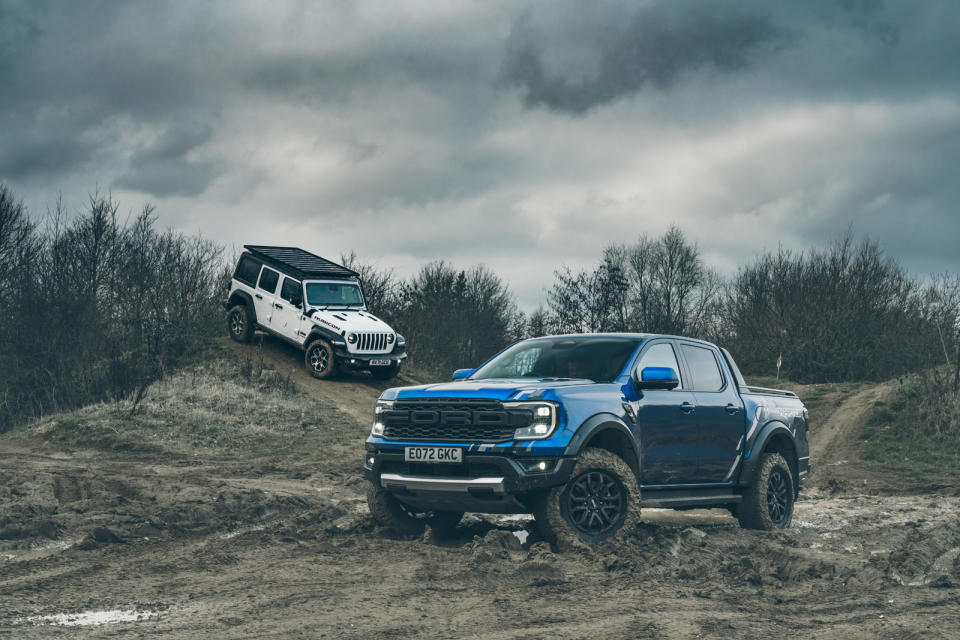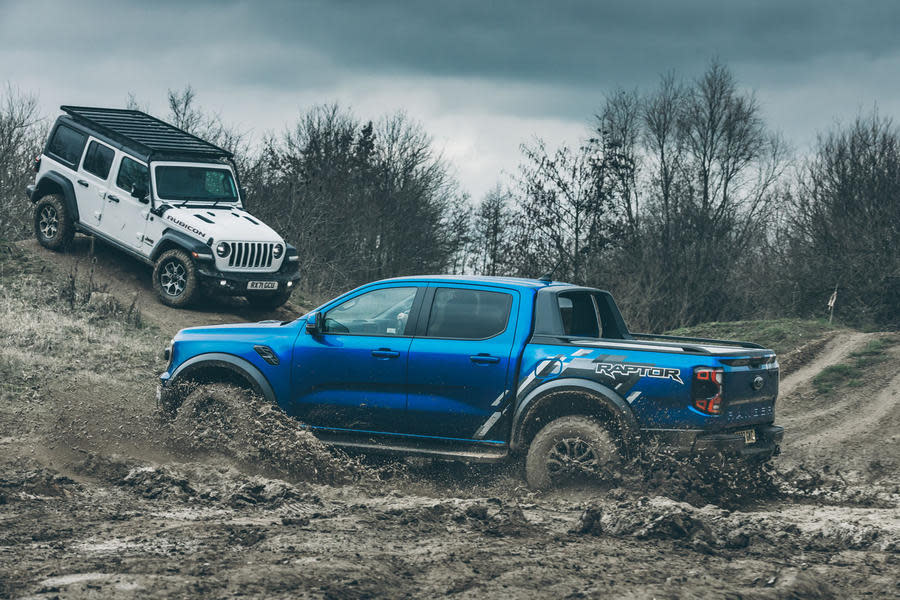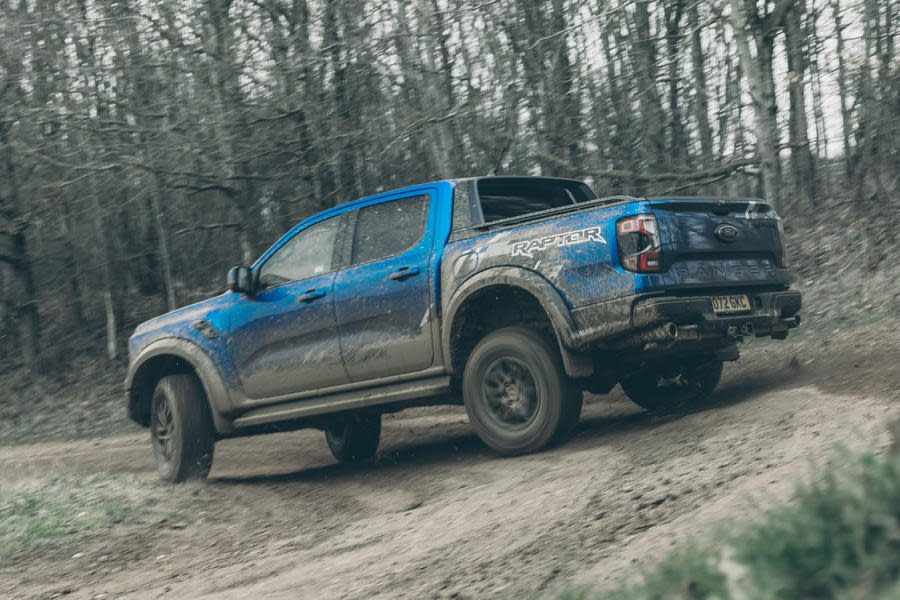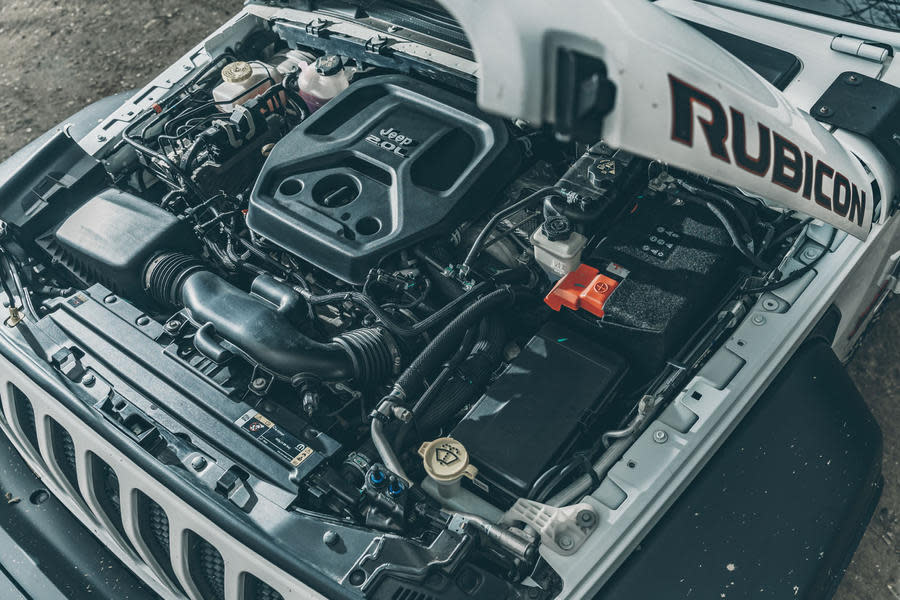Ford Ranger Raptor vs Jeep Wrangler: which is best off-road?

These are two of the most capable off-roaders you can buy
If you want to know how wet it’s been, ask a farmer – or, failing that, the owner of an off-road driving centre.
I feel like I’ve been cold and damp to the core since October, but no, I’m told it has been so dry that extreme 4x4 drivers – mud-pluggers to the end – have found the quarry that we’ve come to already insufficiently challenging, even though it’s only the start of March.
As they’re not wading up to their eyeballs, they now won’t be happy until it’s warm enough to go rock-crawling by day and barbecuing by night.
But I don’t know. Two hours later, when I fish a front numberplate out of a water trough that has two feet of gloop the same consistency as a decent leek and potato soup, it still feels convincingly wet to me.

We’ve been having a go at getting these two cars stuck, see. They’re two of the most capable off-roaders on the market at the moment, even if mud isn’t necessarily at the forefront of their minds.
But which one is best? Read on to find out...
Quick links: Ford Ranger Raptor: introduction - Jeep Wrangler: introduction - Our car's specifications - Off-road performance - Interiors - Verdict and overall specs
Ford Ranger Raptor: introduction
The new car, and the reason we’re here, is the Ford Ranger Raptor. It has already impressed us in Spain, across a vast dry ranch where there was so much space that I could compete with colleagues to see who would get the most air underneath the wheels.
I’ve since had a go in the UK, too, and got on pretty well with it – but I think wide, open territories are where it shows its abilities most convincingly. And you feel less of a berk than you do on the M25.
There’s a Baja option among its driving modes for good reason. The Baja California Desert, on a Pacific-side Mexican peninsular, is home to rallies that bear the Baja’s name, the most famous being the 1000 (actually around 800 miles), into which Ford entered a stock Ranger Raptor last year.
But the initial development team had even bigger expanses in mind.

It was engineered by Ford of Australia, a country where one might have a farm the size of Oxfordshire and, if it turns out that there’s a hole in a rabbit fence on the other side of the property and one needs to go back to the barn to collect a pair of pliers, a V6 pick-up truck is the most timely solution.
The key to its performance lies in its dampers. Made by Fox, they were initially conceived to let Polaris race buggies go rallying.
They’re exceptionally quick-acting, so they can one second be ultra-absorbent over high-frequency inputs and rippled surfaces and then, when they detect they’re maxed out and that you must be airborne, they can stiffen up in a moment for the inevitable landing, before ticking back into fast-input mode.
The speed at which they go between these states and all kinds in between is remarkable.
The previous Ranger Raptor’s suspension was similarly Aussie-built, but it would take you a while to get from field to the workshop, because the only engine option (in the UK, at least) was a 2.2-litre four-cylinder turbodiesel.

Rather more gratifyingly, this time it’s a twin-turbocharged 3.0-litre petrol V6, which, even though it has been sanitised from 400bhp in Australia to 288bhp here so that it meets our emissions rules, is much more like it.
Particularly as it makes 362lb ft of torque from an accessible 2300rpm. And while a 0-62mph dash of 7.9sec would give a rabbit plenty of time to steal some veg and mooch back through the hole through which it came, I’m not sure I would want my 2454kg of pick-up truck to go much faster.
Jeep Wrangler: introduction
At nearly £60,000, the Ranger Raptor doesn’t have many direct rivals, but when it comes to off-the-shelf 4x4 ability, there’s still nothing like the Jeep Wrangler, which happily also starts at £60,000 these days. Goodness, when did that happen?
It doesn’t do the same thing as the Ford, but it does do amazingly good things, particularly at lower speeds, and Jeep has looked after this model fantastically well over the decades.

It’s every inch as well-defined and honed a product as, say, the Porsche 911, deftly evolved with great continuity and so successful that in a good year, Jeep will sell a quarter of a million of them.
It’s possible to argue – and in a former job, I once did – that it’s the single greatest vehicle model line of all time. Yes, the Ford Model T was the first that could be built in huge numbers and the Mini’s transverse engine layout was jolly innovative, but they weren’t driven off the back of a glider on D-Day, were they?
Still, there are big differences in how the Jeep and Ford do things. Nosing through the Wrangler’s specification sheet is a joyful if complicated experience.
Which 4x4 hardware you get depends on which version you specify, and it changes considerably the Wrangler’s off-road credentials (although all versions are capable).
Jeep Wrangler vs Ford Ranger Raptor: Our car's specifications
Ours test Jeep is a Rubicon, which sits top of tree in the UK. The engine is a 2.0-litre four-cylinder turbo petrol making 268bhp, driving through an eight-speed automatic gearbox, with 2WD high, 4WD high and 4WD low ratios.
There are solid axles front and rear, coil springs and Tru-Lok electronic locking differentials front and back.
In the US, Jeep’s people say that Wranglers “stay stock for five minutes”, but this one still is, and it’s running on 255/75 R17 BFGoodrich Mud Terrain tyres.

You can also get a short 2dr Jeep if that matters or even spec factory upgrades to improve your 4dr.
The Ford's specs are more straightforward. There is a diesel option, but given it doesn’t get the fancy dampers and it’s hardly cheaper, I’m not sure why you would bother.
The V6 has a 10-speed auto, 2WD high, 4WD high and 4WD low, plus locking front and rear differentials.

The rear axle is solid but the front suspension is via wishbones. You can’t slacken the anti-roll bars, but the dampers will at least loosen right off, depending on what you’re doing. And it has very similar BFGoodrich rubber.
The Ford is bigger than the Jeep in the first instance because it’s a pick-up, and it has worse approach (32deg) and departure (24deg) angles, but its ground clearance of 272mm is nearly as good and its breakover angle is slightly better, at 24deg.
Jeep Wrangler vs Ford Ranger Raptor: Off-road performance
The Ford’s wade depth is a terrific 850mm, but again, Jeep can do you a snorkel. These clearances matter.
You can tell a lot about where a car will or won’t go off road on the basis of them. So the Jeep noses into banks less often on approach and drags its tail much less frequently, but you get a wince-inducing graunch while cresting a brow at pretty much the same time in both.
The Jeep turns more tightly and seems to articulate its axles more, which is no great surprise.

You can disconnect the anti-roll bars if you want to make the most of the articulation over rough ground, and the relevant body and wheel angles for broaching obstacles are 43.9deg approach, 22.5deg breakover and 37deg departure. It has 274mm of ground clearance and a 760mm wade limit, and all these change if you add some options.
Ultimately, over the right kinds of rock, it will go a bit farther than the Raptor – or certainly with a bit more ease.
This stuff is what it is built to do, plus it’s great fun to do it in, being more engaging, more compact (4.79 metres long and 1.87 metres wide), much lighter (1903kg) and easier to see the edges of. You can even take off the roof, doors and windscreen without too much effort.
It’s a fun lifestyle wagon, and if I lived in the States, I might well daily-drive one.

But the Raptor copes just fine here too, girth aside (it’s 5.4 metres long and 2.0 metres wide). And on one track around the edges of this quarry, it’s just about possible to pitch it into its preferred sphere.
The track is bumpy but straight and third-gear quick. So we’re selecting Baja mode on the dampers and giving it full beans.
From the outside, watching its body stay relatively flat while its big, heavy wheels ripple up and down is seriously impressive.
Jeep Wrangler vs Ford Ranger Raptor: Interiors

Inside, you know you’re being pitched around, yet it’s easy to maintain both a relaxed conversation and grip on the steering wheel.
Try the same in the Wrangler and you will find both endeavours more strained.
Going slower, there’s more head-tossing pitch to the body, the steering bucks more and the wind is knocked from your lungs mid-sentence.
This isn’t what it’s for. And it would be unfair to take a pop at it because of that.

Jeep Wrangler vs Ford Ranger Raptor: Verdict and overall specs
Ford makes the Bronco to rival the Wrangler. The Raptor is a different sort of 4x4. They might both be top of your shortlist, depending on where you live. In the UK, I feel I could more easily get in the Jeep’s zone and enjoy it more often. But you might well not.
1st. Ford Ranger Raptor
V6 brute is more optimised for high-speed hoonery, but has a layer of refinement to make it more accommodating than the Jeep.
2nd. Jeep Wrangler
Ruthlessly capable off-road and nicely honed over the years, but it can't match the Ford for refinement

]]>

 Yahoo Autos
Yahoo Autos 